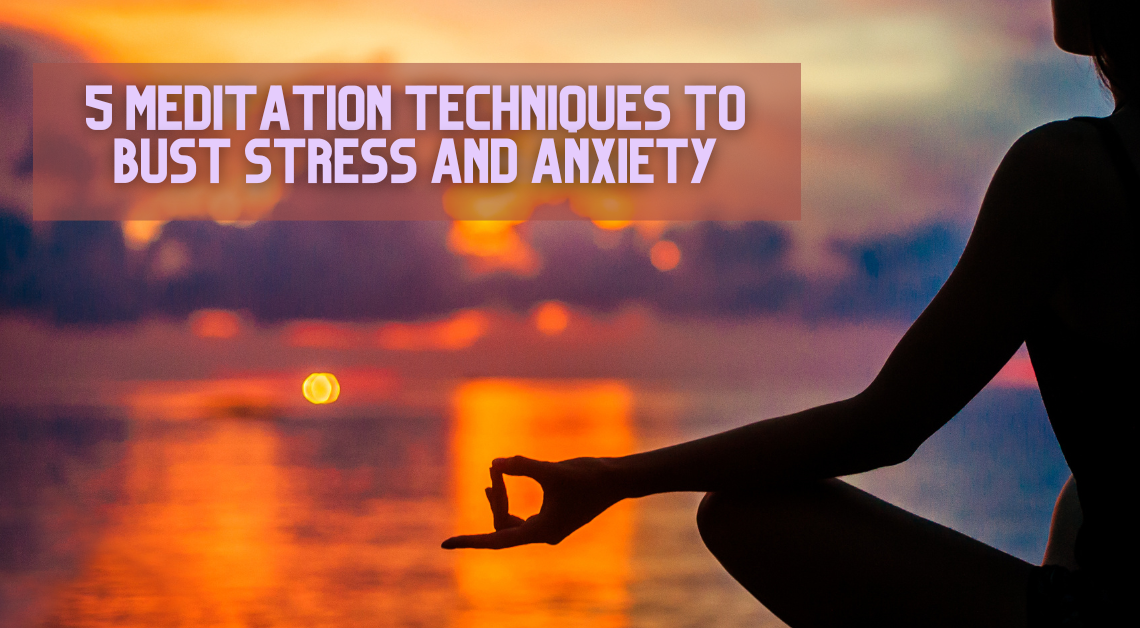
5 Meditation Techniques for Feeling Overwhelmed? The constant juggle of work, relationships, and daily life can take a toll. Stress and anxiety creep in, leaving us drained and on edge. But there’s a powerful tool readily available to combat these feelings: meditation.
Meditation isn’t about emptying your mind or achieving some mystical state. It’s about training your attention and cultivating awareness. By learning to focus on the present moment, we can break free from the cycle of worry and negativity that fuels anxiety and stress.
Here are 5 different meditation techniques you can explore to find your own path to inner peace:
- Mindfulness Meditation:
This is the foundation of many meditation practices. It involves focusing your attention on your breath, bodily sensations, or sounds in your environment, without judgment. When your mind wanders (and it will!), gently guide it back to your chosen focus.
Benefits: Mindfulness meditation can improve focus, reduce stress, and increase emotional regulation.
Getting Started: Find a quiet place to sit or lie comfortably. Close your eyes or soften your gaze. Take slow, deep breaths, feeling your belly rise and fall with each inhalation and exhalation. Notice any thoughts or sensations without getting caught up in them. If your mind wanders, simply acknowledge it and return your focus to your breath. Start with 5 minutes and gradually increase the duration as you become comfortable.
- Body Scan Meditation:
This technique involves bringing your awareness to different parts of your body, one by one. Pay attention to any physical sensations, without judgment. This can help release tension and cultivate a sense of relaxation.
Benefits: Body scan meditation can reduce physical tension, improve body awareness, and promote relaxation.
Getting Started: Get comfortable lying down or sitting. Close your eyes or soften your gaze. Take a few deep breaths. Mentally scan your body, starting with your toes. Notice any sensations of tightness, tingling, warmth, or coolness. Don’t judge the sensations, simply observe them. Continue scanning your body slowly, moving upwards until you reach the crown of your head. Once complete, take a few mindful breaths and gently open your eyes.
- Guided Meditation:
For beginners, guided meditations can be a great way to ease into the practice. A guide will lead you through a visualization or focus point, helping you stay present and reducing the mental effort required. Many free guided meditations are available online or through apps.
Benefits: Guided meditation provides structure and reduces the need for self-directed focus, making it easier for beginners. It can also be helpful for exploring different techniques and visualizations.
Getting Started: Find a guided meditation that suits your needs (stress relief, anxiety reduction, etc.). Choose a quiet, comfortable space. Follow the guide’s instructions, allowing yourself to sink into the experience.
- Loving-Kindness Meditation:
This practice cultivates feelings of compassion and goodwill, starting with yourself and extending outwards to others. It can be a powerful tool for reducing self-criticism and fostering inner peace.
Benefits: Loving-kindness meditation can decrease anxiety, depression, and negativity, while increasing self-compassion and positive emotions.
Getting Started: Sit comfortably and close your eyes. Silently repeat a phrase of self-compassion, such as “May I be happy, may I be healthy.” Once you feel a sense of warmth or well-being, extend the same sentiment to someone you care about. Repeat with a neutral person, someone you have difficulty with, and finally, all beings.
- Movement Meditation:
For those who find sitting still challenging, movement meditation can be a great alternative. Activities like yoga, tai chi, or mindful walking allow you to connect your breath with movement, fostering a sense of presence and focus.
Benefits: Movement meditation combines the benefits of meditation with physical activity, improving mood, reducing stress, and promoting relaxation.
Getting Started: Choose a movement practice that resonates with you (yoga, tai chi, etc.). Focus on the sensations in your body as you move. Breathe deeply and coordinate your breath with your movements. Pay attention to the present moment and avoid getting caught up in thoughts about the past or future.
Remember:
- There’s no “right” way to meditate. Experiment with different techniques and find what works best for you.
- Be patient. It takes practice to develop a consistent meditation habit. Start with short sessions (5-10 minutes) and gradually increase the duration.
- Don’t get discouraged if your mind wanders. It’s natural! Simply acknowledge the distraction and gently bring your attention back to your focus point.
- Consistency is key. Aim to meditate regularly, even if it’s just for a few minutes each day.
Meditation is a journey, not a destination. Embrace the process and enjoy
Also Read – https://festivaldealsrush.com/7-best-benefits-of-getting-more-sleep/

